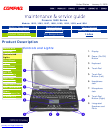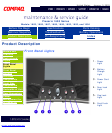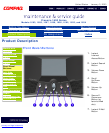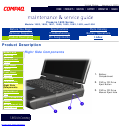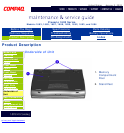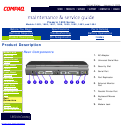
United States January 3, 2003
Presario 1600 Series
Models: 1683, 1685, 1687, 1688, 1690, 1692, 1693, and 1694
Before You Begin Specifications Parts Catalog
Removal Sequence Troubleshooting Battery Operations
Product Description Pin Assignments
Index
Product Description
Models and
Features
Controls and
Lights
Front Bezel
Lights
Front Bezel
Buttons
Left Side
Components
Right Side
Components
Underside of
Unit
Rear
Connectors
Power
Management
for Windows 98
Power Management for Windows 98
The following power management features are available for conserving AC power and extending
battery operating time:
● Power Management Settings
● Sleep
● Hibernation
● Servicing Your Computer - Full Off Mode
● Rebooting After a Lockup
● Battery Operating Time
Pow
er Management Settings
Depending on your patterns of computer use, you can set different levels of power management. These different power
management levels can be activated based on the amount of time passed since the last system activity. System activity
examples include keyboard or mouse movement, CD or DVD playback (while under program control that monitors Sleep),
and modem use.
You can select different conditions or power schemes through Power Management.The optional settings are Home/Office
Desk, Portable/ Laptop, and Always On. From the default settings, you can change the following settings:
● the System goes to Sleep (Standby) mode
● the screen times out and goes blank
● the hard drive spins down
Each of these system components will go to sleep after the selected or default periods of inactivity. (The setting for hard
drive must be less than or equal to the setting for System.)
IMPORTANT:
If you're on a network, it's recommended that you set System Standby to
Never.
There are five categories of power management settings under the Control Panel. The default setting for each feature is
listed below in the tables.
Top of Page
Power Management Properties
Tab: Power Schemes: Plugged in Running on Batteries
Always on System Standby: Never 15 minutes
Turn OFF Monitor
After 3 hours Never
Always on System Standby: After 15 minutes After 10 minutes
Power Management Properties
Tab: Alarms::
Low Battery Alarm: 10%
Critical Battery Alarm 0%
Alarm Actions: X Display Message Notification
Text Action No Action
Top of Page
Power Management Properties
Tab: Power Meter:
Default
Tab: Advanced
Default
Display Properties
Tab: Monitor: Laptop Display (Maximum resolution according to unit display size)
Top of Page
Sleep
You can select Sleep mode instead of turning off the computer when you have finished using it. This allows the computer to
wake up faster than turning it completely off and saves power over the active (On) mode. Compaq Presario Series
Notebook computers have two levels of sleep, Hibernation and Sleep.
Hibernation - by pushing the power button once your computer will perform a save to disk followed by a shut down of the
computer into Off mode.
Sleep - is a low power mode, also referred to as Standby mode. While in Sleep mode, your computer will maintain system
information and open files. Unsaved information will be lost if you turn off your system prior to system wake-up, or if you
lose power while using the AC adapter.
CAUTION: While in Sleep mode, your computer will maintain system information and open
files. Unsaved information will be lost if you turn off your system prior to system wake-up,
or if you lose power while using the AC adapter.
Top of Page
Hibernation Mode
Hibernation helps conserve battery life and protects your data. Hibernation can be a routine power saving event, or can be
the result of a low battery condition. As it enters Hibernation your computer will display a progress screen, as it
automatically saves the machine state before it shuts down and turns itself off. Your computer will automatically go into
Hibernation, when the battery has little power left, or when the system (operating on battery power) has been in Sleep
mode for more than an hour. You can also manually initiate Hibernation by pressing the power button once while the
system is active. To restore the computer's previous state, simply press the power button once again. While waking up, the
computer will display a progress screen.
The following table shows the conditions and indicators for getting in and out of the various power management modes,
Sleep, Hibernation, and Off.
Mode To Initiate To End Indicators
Sleep
Manual keys combination
- Fn+F4
Press any key Flashing green
Power LED
Time Out Default 15 minutes. If on
Battery power (system will not go to
Sleep if on AC power)
Hibernate
Manual - Press Power button once Press Power button
once
No Power LED,
blank screen
Time Out Default If low battery or after 1 hour of
sleep (system will not Hibernate if on AC power)
Off
Perform normal Windows shutdown via
the start button, or press and hold
down the power button for 4 seconds
Press Power button
once
No Power LED,
blank screen
Top of Page
Servicing Your Computer - Full Off Mode
If you need to install or replace components in your system, you must turn the computer off completely. Follow the
instructions above for properly putting the computer into Off mode, unplug from the outlet, and remove the battery (see
battery section for instruction on removing battery).
Rebooting After a Lockup
Occasionally you may encounter a frozen keyboard or a locked screen. To reboot your computer (as if from a cold start)
press and hold down the Power Button for at least four seconds, which will cause a manual shutdown. Then, restart it with
a single press of the Power Button. If it still doesn't recover, press the Power Button and hold it for four seconds to shut it
down, then, remove the battery or unplug the AC power for at least 30 seconds. Reinsert the battery or reconnect AC
power and press the Power Button once to reboot.
Top of Page
Battery Operating Time
Battery operating time is affected by variables, such as the following:
● Power conservation settings
● Hardware configuration
● Software applications
● Installed options
● Display brightness
● Hard drive usage
● Power button
● Changes in operating temperature
● Type and number of installed PC Cards
For more information on increasing battery pack operating time, conditioning the battery pack, and disposing of a used
battery pack, refer to the
Battery Pack Operations.
Top of Page
privacy and legal statement











